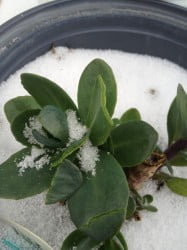
Did the recent cold snap leave some of the plants in your landscape looking a little haggard? If you purchased perennial plants that were already showing strong foliage growth or blooms, then the recent temperatures in the teens and single digits most likely left them looking wilted, discolored, or worse.
Don’t despair, though. While many plants took damage to their foliage and flowers, the temperatures just weren’t low enough for long enough to have caused major damage to the roots. Soil provides great insulation for roots – in fact, nearly all perennials, trees, and shrubs will have a higher probability of surviving a cold snap when planted in the ground than they will above the ground in a pot. When cold air is able to circulate around the root ball of a plant left in its pot, the soil temperature in the pot will drop much more rapidly than the in-ground soil temperature. If you haven’t had time to plant your perennials yet, moving them into a garage where temperatures might only drop into the 20’s instead of teens or single digits can improve the odds of survival.

Even if your plants spent the last few days outside in their pots, it is highly likely they survived. We grow about 90% of the perennials we sell right here at Fort Collins Nursery, and we grow them in colder-than-normal conditions to ensure they are well acclimated to tolerate cold snaps exactly like the one we just experienced. On top of that, we specialize in hardy plants for northern Colorado and southern Wyoming, which means these plants are selected to be tough!
So what’s a gardener to do when the tops of their plants have been damaged by frost? The first step is to do nothing. That’s right, nothing. Wait for the plants to begin producing new growth. Once new growth has begun, you can asses the amount of top damage incurred. Using a sharp pair of pruners or shears, remove any foliage that is damaged, leaving healthy new growth alone. At most, cut the plants back so only 1″-2″ of foliage remain. The plant will continue to regenerate new growth as the temperatures rise. Be patient, though, as we are not expecting a rapid increase in temperature. You should see regrowth beginning in 2-3 weeks, although if warmer weather comes along, it could happen sooner. Treat your plants as though they were dormant – water them just enough to keep the roots from drying out, and increase watering as more foliage appears.
As always, if you have any major concerns about your plants, call us! All our hardy perennials, trees, and shrubs are guaranteed for 1 year from the date of purchase, and we encourage you to wait for warmer weather to awaken your plants. Don’t pull them out of the ground right away, as it is likely they have survived and have just ducked their heads back down to dodge this dodgy weather.
Originally published on April 10th, 2013. Updated on April 22nd, 2013.
